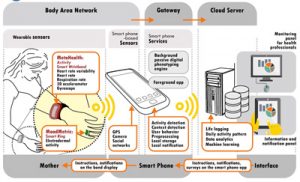
UNITE WIoT-based monitoring-intervention architecture
Aug. 30, 2020
The SURF-IoT Summer Talk series continued last week with presentations by Amir M. Rahmani, Assistant Professor, School of Nursing, and Nikil Dutt, Distinguished Professor, Department of Computer Science.
Rahmani and Dutt discussed their preliminary research on the potential of IoT technology to advance health care for pregnant women and their current National Science Foundation program project.
Rahmani, also a computer scientist, is a member of the Health SciTech Group at UC Irvine. (HealthSciTech.org). “What we do is actually very end to end, meaning that when we build the solution we need to deal with different aspects,” he says. Health care IoT involves working with the sensors and wearable technology, processing bio-signals from the devices, situation recognition to capture life events, cloud edge to handle the data and perform data analytics. The data analytics – modeling, prediction and personalization, can provide reasoning, cause and assessment to make medical decisions and recommendations that can be delivered via smart notifications and alerts, he explains.
The researchers are collaborating on a project funded by the National Science Foundation program, Smart & Connected Communities Effort (S&CC). The mission of the S&CC program is to support interdisciplinary, integrative research that undertakes meaningful community engagement, Dutt says.
Their project, UNITE (UNderserved communITiEs) Maternity Care Coordination Model, provides services to underserved pregnant women in Orange County by connecting them with their health providers via wearable technology and applications.
The model consists of providing pregnant women with a smartwatch and ring that monitors heath signals, including heart rate, activity, diet and contextual information, Dutt says. “A smart phone acts as a gateway to upload data to the cloud and provides the ability to interact with apps for feedback. Recommendations can be sent to the mother as well as to the health care provider,” he adds.
” UNITE presents a community engagement model that is smart and coordinated, using technology to proactively reach out to the community, and personalized intervention and education for improved self-management by the women. The project champions a model that is scalable in size, portable across different ethnic communities, and promises improved outcomes through better self-management and community enhanced motivational factors,” Dutt says.
This summer, four SURF-IoT fellows are working with Dutt and Rahani on a variety of Health IoT projects.
Yuchong Chen, math & quantitative economics major
Project: WIoT Data Analysis for Dementia Family Caregiver Home Visit Intervention Study
Family caregivers of persons with dementia (PWD) in Orange County lack access to care information in their own language. This particularly affects Vietnamese, Korean and Latino immigrants. Consequently, they often underutilize services and tend not to seek treatment until the situation becomes a crisis. Immigrant families of PWD are understudied and therefore less likely to receive guidance and assistance for their own health and wellness. A community health study used two interventions to monitor this population:
• A home visit program using mindfulness and caregiver education to promote mental health
• Wearable Internet of Things (WIoT) technology to monitor the resulting physiological changes
Chen’s role in this project is to analyze the WIoT data collected during the intervention period to find and demonstrate trends and correlations in physical activity, stress, heart rate and sleep recorded by smartwatches.
Aviv Benchorin, computer science major
Project: Live Update Service for ZotCare Multi-Level IoT-Based Health Monitoring System
Wearable technology has allowed for continuous collection of data, including vital signs, physical activity and environmental data. They have been used to connect underserved pregnant women in Orange County with health care providers who can monitor their data and identify health issues early.
Benchorin’s role in this project is to design a live update service for mobile apps that will push these updates to a smartwatch. Doing this will enable the researchers in the long-term study to update their wearable applications remotely.
Jonathan Sugijoto, computer engineering major
Project: Smart Watches/Rings as a Predictive/Preventative for Sleep Promotion in Pregnant Women
Pregnant women often have sleep difficulties due to unstable hormones and other sleep disorders. As a result, they suffer from extreme mental and physical fatigue.
Sleep disorders are treatable. However, the condition needs to be recognizable in this population so it can be treated. The goal of this project is to be able to use different vital readings of pregnant women as they sleep. The readings will be used to predict probable complications and warn of potential health issues before they become serious.
Sugijoto’s role is to parse the data collected so far into custom readable files that can be read by programs used to predict these complications. He isalso learning to use recurrent neural networks and implement them to predict methods for alleviating sleep disorders.
John Cong Le, computer science major
Project: Mobile and Webapp for ZotCare Multi-Level IoT-Based Health Monitoring System
This project provides services to underserved pregnant women in Orange County by connecting them with their health providers via wearable technology and applications. The primary focus of the project will be to develop on top of the mobile application and create a dashboard. The mobile app enables communication with study participants and allows for the collection of subjective data through questionnaires. The dashboard provides information and analysis of the participants’ data and helps them communicate and provide interventions.
Le’s role is to design and develop the features for mobile and web platforms, UI/UX design and teamwork, and large scale application development.
SURF IoT Fellows will mark the culmination of the ten-week program on Sept. 10. During on online event, students will present their individual projects, discuss their findings and answer questions about their work.
To view Prof. Rahmani and Prof. Dutt’s presentation, visit https://youtu.be/gvQrfpYK7hE
– Sharon Henry
